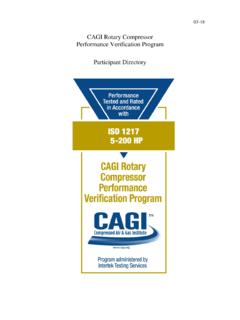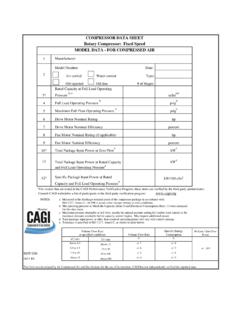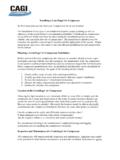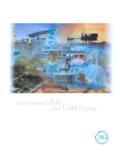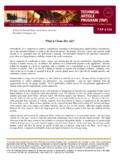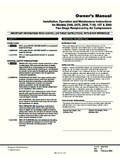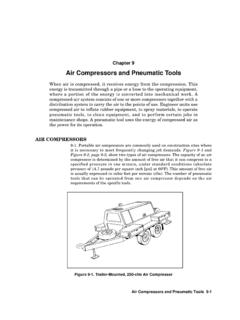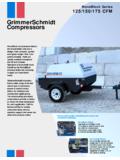Transcription of Air Compressor
1 Air CompressorSelection & Application through 30 HPYEARS OF INDUSTRYLEADERSHIPP refaceThe purpose of this publication is to help users understand the basics of compressed air as a power source and to provide initial technical guidance for selecting the right air Compressor for specific applications. The central focus is on packaged complete unit air compressors, most commonly used in sizes 30 horsepower and below as measured according to standards for continuous duty compressors. Content has been provided by members of the reciprocating Compressor and Rotary Positive Compressor Sections. Products within the scope of these sections are most frequently used for general purpose industrial air supply, but they also find use in off-shore drilling, construction jobs, locomotives, ships, mining and other specialized applications. Membership of the reciprocating Compressor and Rotary Positive Compressor Sections:ALMiG USA CorporationAtlas Copco Compressors LLCBOGE AmericaChicago Pneumatic ELGi Compressors USA, SystemsGardner DenverIngersoll RandKaeser Compressors, CompressorsQuincy CompressorSaylor-Beall Manufacturing CorporationSullivan-PalatekVisit for the most up-to-date listing of members.
2 If you require additional information that is not contained in this document, contact a Compressor manufacturer of your choice for additional information and instructions. 2 ContentsCompressed a. How Can Air Generate Power? b. Where is Compressed Air Used?Advantages of Air Power ..4 a. Air Power versus Electric Power b. Air Power versus Hydraulic PowerTypes of Compressors ..5 a. reciprocating Type 1. Single-Stage 2. Two-Stage 3. Rocking Piston Type 4. Diaphragm Type b. Rotary Type 1. Rotary Sliding Vane Type 2. Rotary Helical Screw Type 3. Scroll TypeTypes of Controls ..7 Types of 8 a. V-Belt Drives b. Gear Drives c. Direct Drives d. Engine DrivesAir Compressor Packaged Units ..8 Air Compressor Performance ..11 a. Delivery b. DisplacementAccessories ..11 a. Air Receiver b. Air Treatment Products c. Belt Guard d. Diagnostic Controls e. Intake Filter f. Magnetic Motor Starters g. Variable Speed DrivesAir Compressor Installation.
3 12 Air Compressor System ..13 How to Select an Air Compressor ..16 a. Industrial Type Tools b. Automotive Service Shops c. For Use with Air Cylinders d. Air Flow Through OrificesCompressor Selector Chart ..19 Useful Formulae ..24 Glossary ..253 Compressed AirHow Can Air Generate Power?When air is compressed, it is under pressure greater than that of the normal atmospheric pressure and it characteristically attempts to return to its normal state. Since energy is required to compress the air, energy is released as the air expands and returns to atmospheric pressure. Air compressors were designed to compress air to higher pressures and harness this potential energy source. Unlike other sources of power, no conversion from another form of energy such as heat is involved at the point of application. Compressed air or pneumatic devices are therefore characterized by a high power-to-weight or power-to-volume ratio. Not as fast as electricity or as slow as hydraulics, compressed air finds a broad field of applications for which its response and speed make it ideally suited.
4 Where there is an overlap, the choice often depends on cost and efficiency and air is likely to hold the is a utility that is generated in-house, so owners have more control over it than any other utility. In addition, air does not possess the potential shock hazard of electricity or the potential fire hazard of oils. However, compressed air is under pressure and can cause harm and bodily damage if not respected. Safety codes and regulations should be followed when working with compressed air. The advantages of air power will be discussed further in the proceeding is Compressed Air Used?Compressed air powers many different kinds of devices. It can be used to push a piston, as in a jackhammer; it can go through a small air turbine to turn a shaft, as in a dental drill; or it can be expanded through a nozzle to produce a high-speed jet, as in a paint sprayer. Compressed air provides torque and rotation power for pneumatic tools, such as drills, brushes, nut runners, riveting guns and screwdrivers.
5 Such tools are generally powered by some form of rotary air motor such as the vane or lobe type or by an air turbine. Equally common are devices producing lateral motion and direct force, either steady or intermittent. Common examples are clamps, presses and automatic feeds. Air pressure can also be used to accelerate a mass, which then exerts an impact upon an anvil, as in paving breakers and pile drivers. Common applications in industrial plants and on construction sites are air-powered nail guns, staplers, torque wrenches, screwdrivers, paint spraying and conveying of material. In paint spraying and in air conveying, the dynamic pressure of the air imparts of Air PowerWhen there are a dozen or more forms of energy to choose from, what advantages does air power offer? Here, compressed air stacks up against two of its competitors electricity and hydraulics. Air Power versus Electric Power Cost: Air tools have fewer moving parts and are simpler in design, providing lower cost maintenance and operation than electric tools.
6 Flexibility: Air tools can be operated in areas where other power sources are unavailable, since engine-driven portable compressors are their source of air power. Electric power requires a stationary : Air-powered equipment eliminates the dangers of electric shock and fire hazard. Air tools also run cooler than electric tools and have the advantage of not being damaged from overload or stalling. Weight: Air tools are lighter in weight than electric tools, allowing for a higher rate of production per man-hour with less worker Power versus Hydraulic PowerCost: An air system has fewer parts than a hydraulic system, lowering service and maintenance costs. Also, the use of a single compressed air supply permits operation of many separate systems at once. Hydraulic systems require more complex and costly controls. Flexibility: Compressed air systems offer simpler installation than hydraulics, particularly where tools are frequently interchanged.
7 Compressed air systems also offer better adaptability for automation and flexibility for changing or expanding operations. Maintenance: Air systems have less downtime than hydraulic systems because they have less complex controls. Less preventive maintenance is required with air, whereas hydraulic fluids must be monitored and replaced : Hydraulic devices operating near open flame or high temperatures present fire hazards, unless fire-resistant fluids are used. Leakage in hydraulic systems can result in the presence of dangerous hydraulic fluids and even complete system shutdown. In contrast, compressed air devices operate with lower system pressures and accidental air leaks release no : Lighter weight air tools contribute to a lower operating fatigue as compared to heavier hydraulic of CompressorsAir compressors in sizes 30 horsepower and below include both reciprocating and rotary compressors, which compress air in different ways.
8 Major types of reciprocating compressors include reciprocating single acting, reciprocating diaphragm and reciprocating rocking piston type. Major types of rotary air compressors include rotary sliding vane, rotary helical screw and rotary scroll air compressors. reciprocating Single Acting Compressors reciprocating single acting compressors are generally of one-stage or two-stage design. Compressors can be of a lubricated, non-lubricated or oil-less design. In the single-stage Compressor , air is drawn in from the atmosphere and compressed to final pressure in a single stroke. The single-stage reciprocating Compressor is illustrated in (Figure 1). Single-stage compressors are generally used for pressures of 70 psi (pounds per square inch) to 135 psi. In the two-stage Compressor , air is drawn in from the atmosphere and compressed to an intermediate pressure in the first stage. Most of the heat of compression is removed as the compressed air then passes through the intercooler to the second stage, where it is compressed to final pressure.
9 Two-stage compressors can include two cylinder designs. The two-stage reciprocating Compressor is illustrated in (Figures 2a and 2b). Single and two-stage reciprocating compressors are frequently used in auto and truck repair shops, body shops, service businesses and industrial plants. Although this type of Compressor is usually oil lubricated, hospitals and laboratories can purchase oil-less versions of the compressors as illustrated in (Figure 3 ). HeadValve PlateConnecting RodAir Intake FilterPistonFly WheelCrankcaseReciprocating Single StageLow-Pressure Piston CylinderHigh-Pressure Piston CylinderInlet &Discharge ValvesCentrifugalUnloaderPiston PinsIntercoolerHeadCrankshaftCrankshaftA ccess PlateConnected RodsCrankcaseAir InletAir DischargeInterstage CoolerLow-PressurePiston CylinderHigh-PressurePiston CylinderHeadFly WheelAir InletInterstage CoolerConnectingRodCrankcaseReciprocatin g Two-stage, Four CylinderReciprocating Two-stage, Two Cylinder6 Rocking Piston TypeRocking piston compressors are variations of reciprocating piston type compressors (Figure 4).
10 This type of Compressor develops pressure through a reciprocating action of a one-piece connecting rod and piston. The piston head rocks as it reciprocates. These compressors utilize non-metallic, low friction rings and do not require lubrication. The rocking piston type compressors are generally of a smaller size and lower pressure capability. Diaphragm TypeDiaphragm compressors (Figure 5) are a variation of reciprocating compressors. The diaphragm Compressor develops pressure through a reciprocating or oscillating action of a flexible disc actuated by an eccentric. Since a sliding seal is not required between moving parts, this design is not lubricated. Diaphragm compressors are often selected when no contamination is allowed in the output air or atmosphere, such as hospital and laboratory applications. Diaphragm compressors are limited in output and pressure and they are used most often for light-duty applications. Rotary Sliding Vane TypeThe rotary vane Compressor consists of a rotor mounted eccentrically in a housing (Figure 6).

